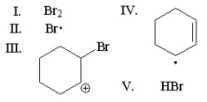A) 5
B) 8
C) 10
D) 12
E) 16
G) B) and C)
Correct Answer

verified
Correct Answer
verified
Essay
How many monochlorinated products would be obtained from 2-methylbutane? Show the structures and give their IUPAC names.
Correct Answer

verified
Correct Answer
verified
Short Answer
Would chlorination or bromination of 2,5-dimethylhexane produce a greater yield of 1-halo-2,5-dimethylhexane?
Correct Answer

verified
Correct Answer
verified
Short Answer
Provide the reagents necessary for carrying out the transformation of 2-methylheptane to 2-methyl-2-heptene.
Correct Answer

verified
1. Br2, hυ
...View Answer
Show Answer
Correct Answer
verified
...
View Answer
Multiple Choice
Give the best product for the reaction. 
A) ![]()
B) ![]()
C) ![]()
D) ![]()
E) ![]()
G) B) and E)
Correct Answer

verified
Correct Answer
verified
Short Answer
The following molecule contains how many 1°, 2°, and 3° hydrogens? 
Correct Answer

verified
Correct Answer
verified
Multiple Choice
How many distinct dichlorination products can result when isobutane is subjected to free radical chlorination?
A) 1
B) 2
C) 3
D) 4
E) 6
G) A) and D)
Correct Answer

verified
Correct Answer
verified
Multiple Choice
What reagent can best be used to convert cyclopentene to 3-bromocyclopentene in a single step?
A) Br2, hυ
B) NBS, Δ
C) HBr
D) HBr with peroxide
E) none of the above
G) A) and C)
Correct Answer

verified
Correct Answer
verified
Essay
What sequence of reagents can be used to convert 3,3-dimethylpentane into 3,3-dimethyl-2-pentanone?
Correct Answer

verified
1. Br2, hν
...View Answer
Show Answer
Correct Answer
verified
...
View Answer
Multiple Choice
Which of the following is a step in the mechanism of the reaction shown? 
A) ![]()
B) ![]()
C) ![]()
D) ![]()
E) ![]()
G) C) and E)
Correct Answer

verified
Correct Answer
verified
Essay
Write a detailed, stepwise mechanism for the following reaction. 
Correct Answer

verified
Correct Answer
verified
Multiple Choice
Given the bond dissociation energies below (in kcal/mol) , estimate the ΔH° for the propagation step  CH3CH2CH2-H 98 (CH3) 2CH-H 95
Cl-Cl 58
H-Cl 103
CH3CH2CH2-Cl 81
(CH3) 2CH-Cl 80
CH3CH2CH2-H 98 (CH3) 2CH-H 95
Cl-Cl 58
H-Cl 103
CH3CH2CH2-Cl 81
(CH3) 2CH-Cl 80
A) -22 kcal/mol
B) +22 kcal/mol
C) -40 kcal/mol
D) +45 kcal/mol
E) -45 kcal/mol
G) A) and E)
Correct Answer

verified
Correct Answer
verified
Essay
Consider the reaction: CH3CH2 ∙ + Br2 → CH3CH2Br + Br ∙. Given that this reaction has an activation energy of +6 kcal/mol and a ΔH° of -22 kcal/mol, sketch a reaction-energy profile for this reaction. Label the axes and show Ea and ΔH° on your drawing.
Correct Answer

verified
Correct Answer
verified
Short Answer
Given the bond dissociation energies below (in kcal/mol), calculate the overall ΔH° for the following reaction: (CH3)3CH + Br2 → (CH3)3CBr + HBr (CH3)3C-H 91 (CH3)3C-Br 65 Br-Br 46 H-Br 88 CH3-Br 70
Correct Answer

verified
Correct Answer
verified
Essay
Provide the major organic product of the following reaction. 
Correct Answer

verified
Correct Answer
verified
Multiple Choice
Which of the following is not an intermediate or product in the reaction of 

A) I
B) II
C) III
D) IV
E) V
G) A) and B)
Correct Answer

verified
Correct Answer
verified
Multiple Choice
Calculate the percentage of 2-chloro-2-methyl butane in the following reaction. 
A) 11.56%
B) 27.77%
C) 23.14%
D) 35.18%
E) 13.88%
G) All of the above
Correct Answer

verified
Correct Answer
verified
Multiple Choice
How many distinct monochlorinated products, including stereoisomers, can result when the alkane below is heated in the presence of Cl2? 
A) 2
B) 4
C) 5
D) 6
E) 8
G) A) and E)
Correct Answer

verified
Correct Answer
verified
Multiple Choice
Identify the most stable radical.
A) ![]()
B) ![]()
C) ![]()
D) ![]()
E) ![]()
G) A) and D)
Correct Answer

verified
Correct Answer
verified
Multiple Choice
Calculate the percentage of 2-chloro-3,4-dimethylheptane formed in the following reaction. 
A) 6) 70
B) 11.16
C) 16.96
D) 22.32
E) 26.80
G) A) and D)
Correct Answer

verified
Correct Answer
verified
Showing 81 - 100 of 130
Related Exams